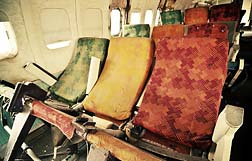 Attorney John Greaves, of Baum, Hedlund, Aristei & Goldman, is an experienced pilot and airline accident lawyer. He says that there are often many factors that contribute to a plane crash.
Attorney John Greaves, of Baum, Hedlund, Aristei & Goldman, is an experienced pilot and airline accident lawyer. He says that there are often many factors that contribute to a plane crash."At this point the major factor appears to be that the aircraft was suddenly and improperly pitched upward while on final approach for landing, at a slow speed," Greaves says. "This caused the aircraft wings to lose their lift and the aircraft rolled and plunged to the ground. It further appears that the sudden nose up attitude of the aircraft was caused by the pilot's reaction to the aircraft itself pushing the nose down automatically to prevent the aircraft wings from stalling (losing their lift). The automatic push of the pitch down by the aircraft itself appears to have occurred because the pilots had activated the de-icing system in an effort to shed ice from its wings. The pilots may have been unaware that the airplane would then stall or appear to stall at a higher airspeed than if the de-icing boots had not been activated.
"Whether there was actually ice on the wings or not; whether the speed of the aircraft was actually sufficient at that time or not; and why the pilot and the aircraft reacted the way they each did are other questions which we believe will be further addressed at the upcoming NTSB hearings. In any event, the pilot's actions were clearly wrong and the aircraft's immediately preceding actions of pitching the aircraft down may have been misleading to the pilot. However, the action of the pilots in pulling the nose of the aircraft up to an angle that would cause an unrecoverable wing stall is, in our view, inexcusable."
According to the National Transportation Safety Board (NTSB), the aircraft stalled because of a separation of airflow over the wing and ensuing roll 2 seconds after activation of the stick shaker. The stick shaker activates when the aircraft is approximately 5 knots above the speed at which the wings will stall. It is important to note that in this context, "stall" refers to a loss of lift, which is the force that holds the aircraft up in the air. "Stall" in this context does not refer to engine performance (as it is used when referring to a car stalling).
"Wings with ice accumulation stall at higher speeds than without ice," says Greaves. "The reason the stall speed increases with ice is that ice makes the wing surface rougher and prone to airflow disturbances that destroy lift. Since air, like all matter, has inertia, flying faster smoothes out the air by giving it less time to react to the rough ice. The NTSB has indicated that simply because the ice protection system was engaged, whether or not there was ice on the wings, the stall warning system ('stick shake/push') automatically reset itself to activate at an artificially higher speed (in this case about 130 knots as opposed to the 105 knots when the ice protection system is not activated).
"Even if there was no ice accumulation, therefore, this emergency warning would have indicated to the flight crew that the wings were about to stall when, in fact, they may not have been near stall at all. Apparently induced by the stall warning, however, the flying pilot suddenly and forcefully pulled the stick back, causing the nose to pitch up 31 degrees, decreasing speed, increasing the angle of attack, and causing the wings to lose all lift."
One aspect of the flight that is still being considered is whether or not the pilot should have been using the plane's autopilot system while flying in icing conditions. Greaves says that Colgan Air's policy was that the pilot should hand-fly the plane in icing conditions. Hand-flying the plane would allow the pilot to know that the aircraft-handling properties had changed because of ice. This would be made clear because the yoke would feel "mushy" and the aircraft would be less responsive to the pilot's control input. Flying on autopilot would not provide the pilot with this information because the autopilot would subtly compensate for the aircraft's change in performance.
"Airline crashes are rarely the result of one factor and are usually caused by a confluence of factors," Greaves says. "In this respect, this crash appears to be no exception. For instance, the icing conditions led to the activation of the de-icing system, the relatively slow speed and flight at lower altitudes (where ice is likely to form) of a turboprop airplane (as compared to a pure jet) is conducive to ice accumulation on the wings and tail surfaces, the fact that the pilots were utilizing the autopilot instead of hand-flying the airplane, and the reaction by the pilots to the automatic stick shake/push system, and other factors as well, may all have played a contributory role in causing the crash."
READ MORE PLANE CRASH LEGAL NEWS
John A. Greaves is a former airline captain and seasoned aviation accident lawyer who has represented hundreds of airline accident victims in more than 35 airline disasters. He was also on the team that negotiated an unprecedented official public apology by an airline as part of the settlement terms in the 2003 Charlotte, NC crash of Air Midwest Flight 5481. John has also served on several plaintiffs' steering committees overseeing airline accident cases involving multi-district litigation.
As an airline transport rated pilot and former captain for Comair, John Greaves has flown over 10,000 hours total flight time since 1966 and over 3,000 hours as a Captain in Part 121 and Part 135 scheduled airline operations.
